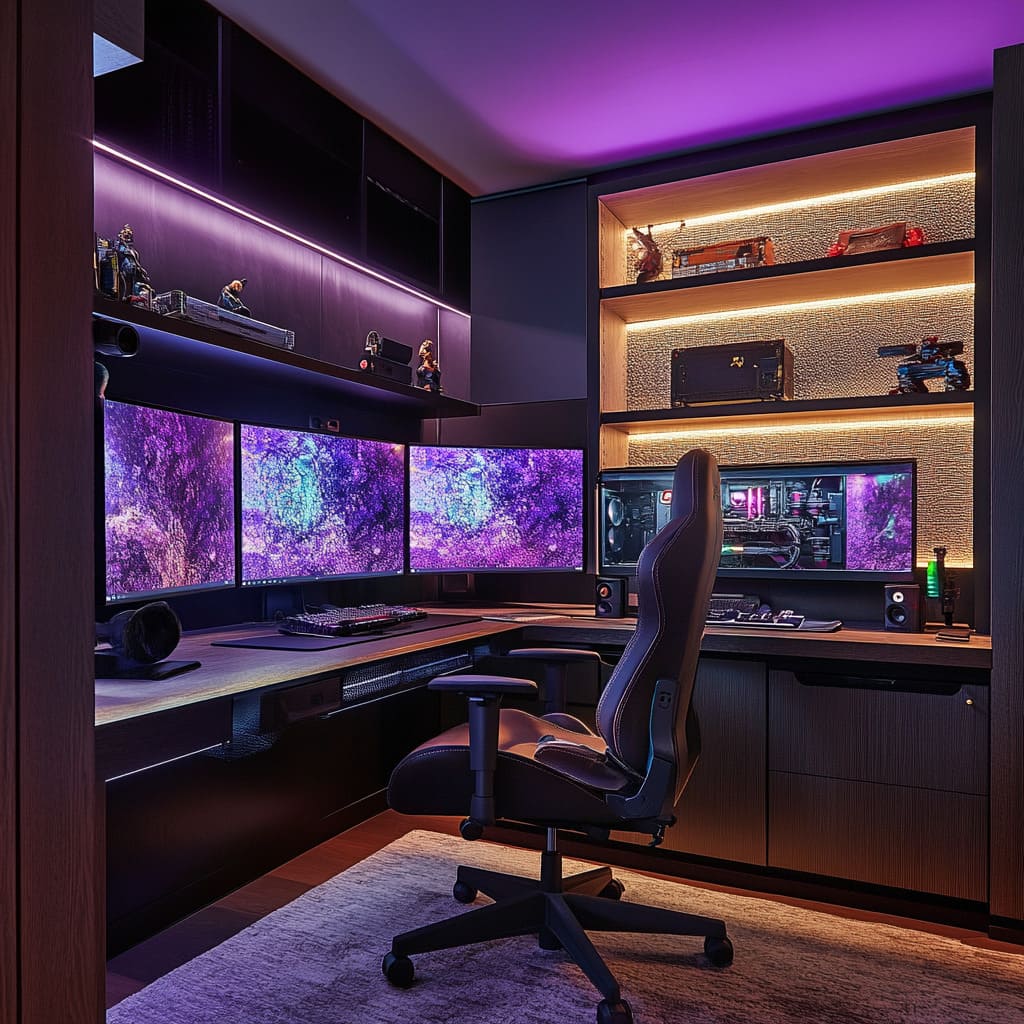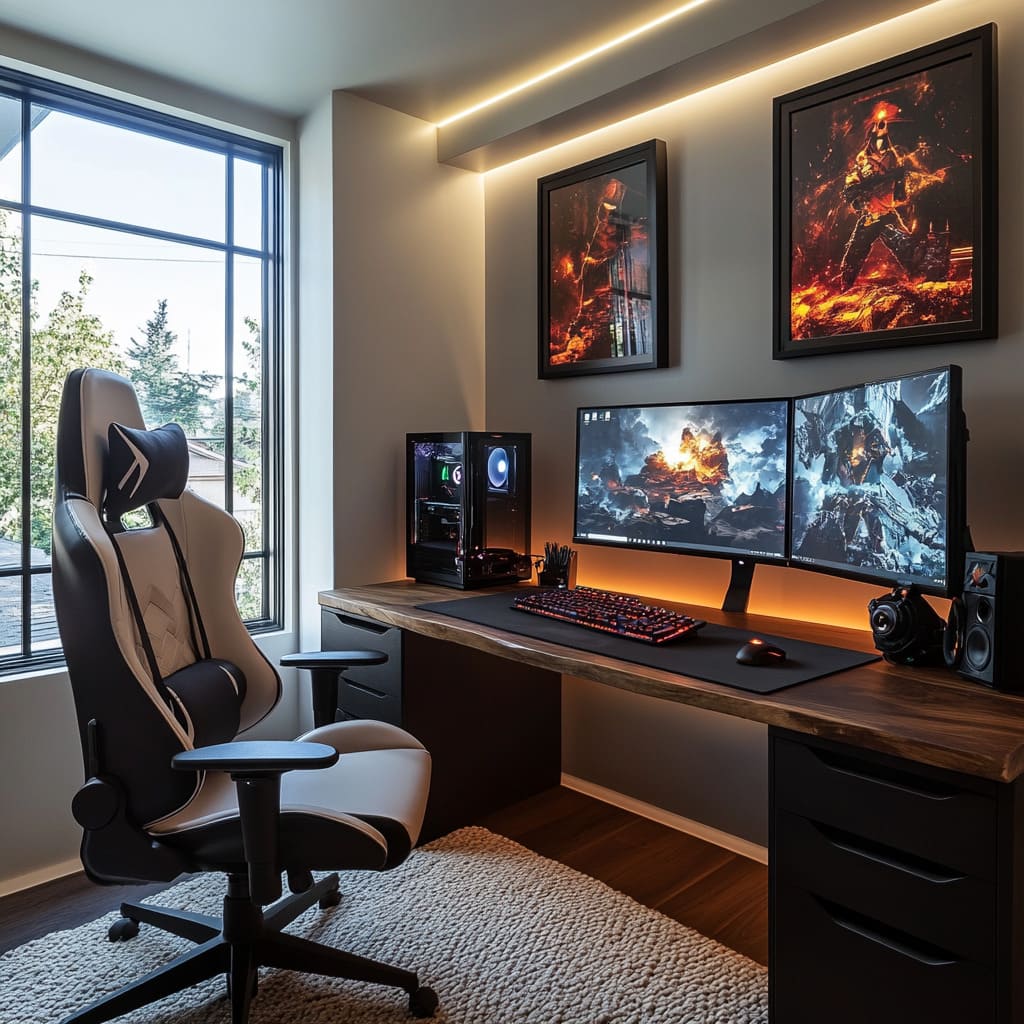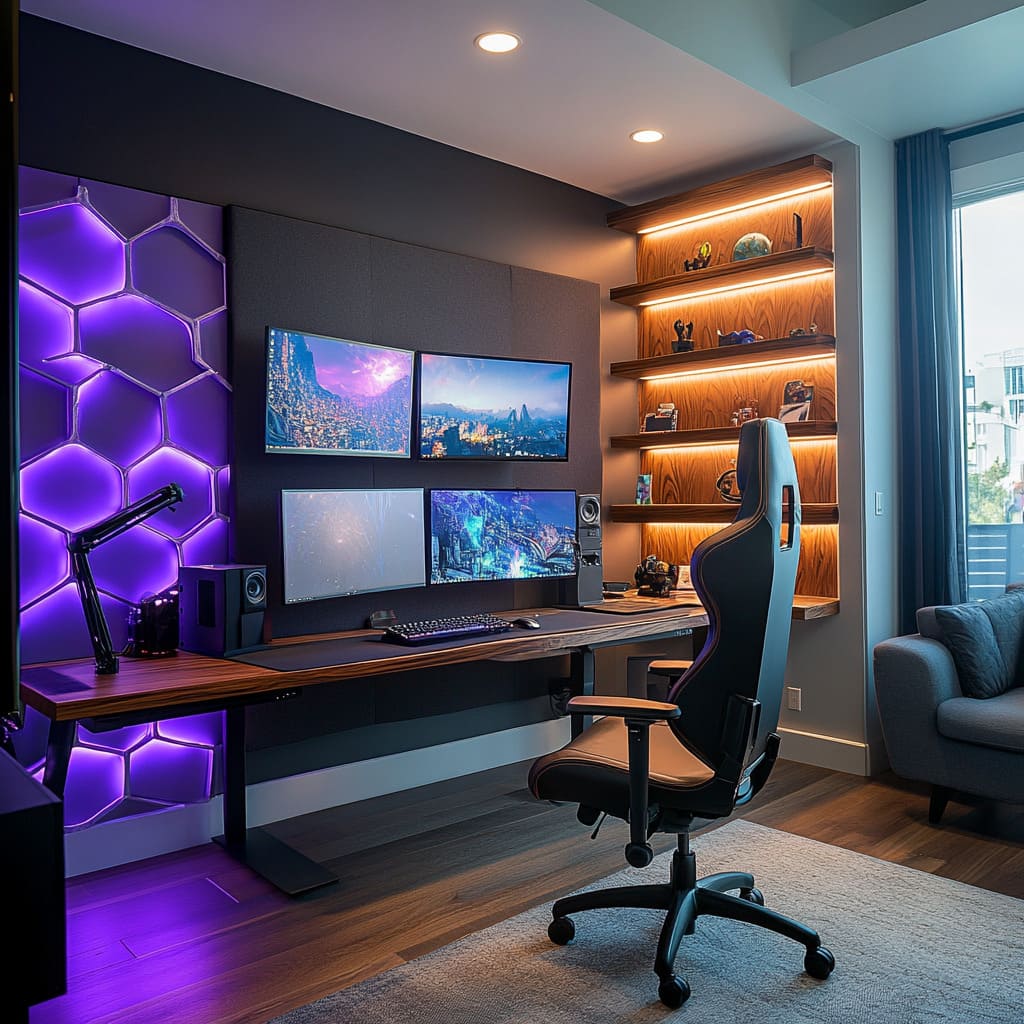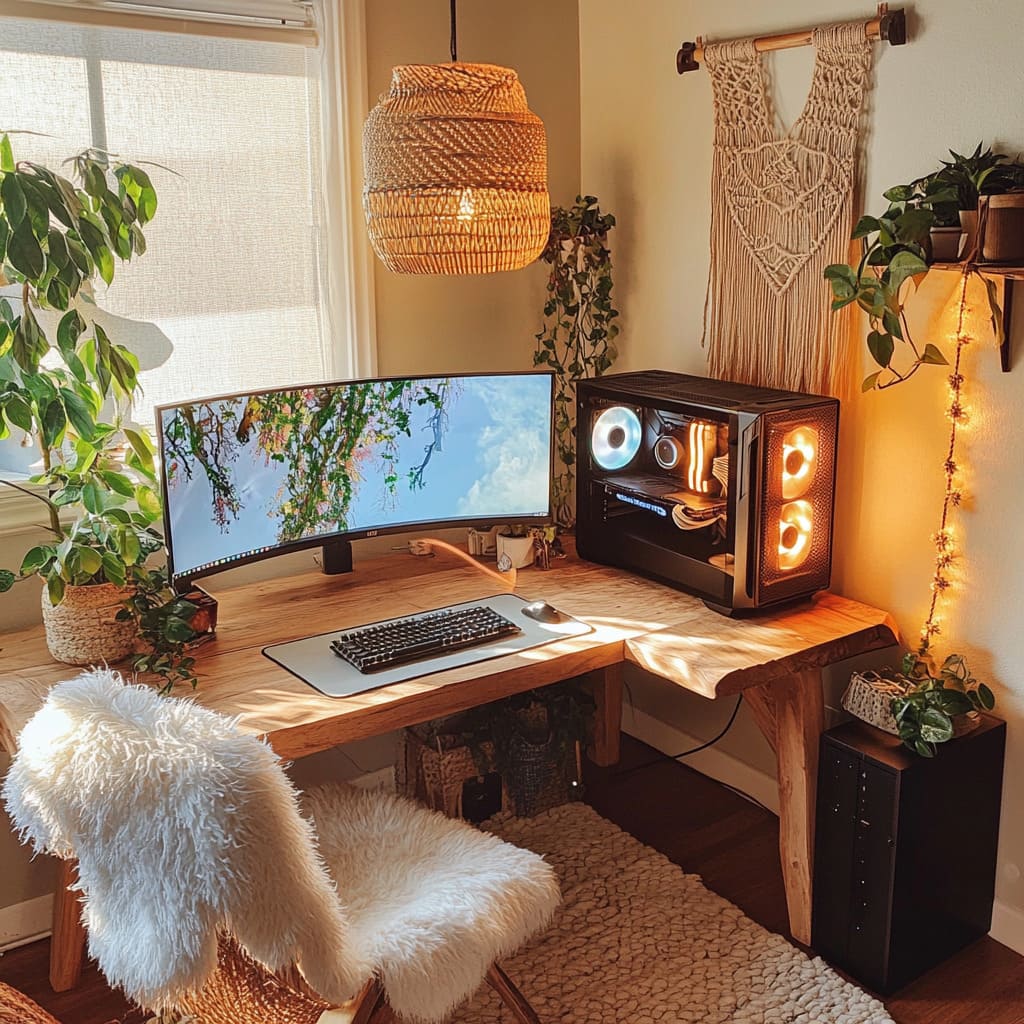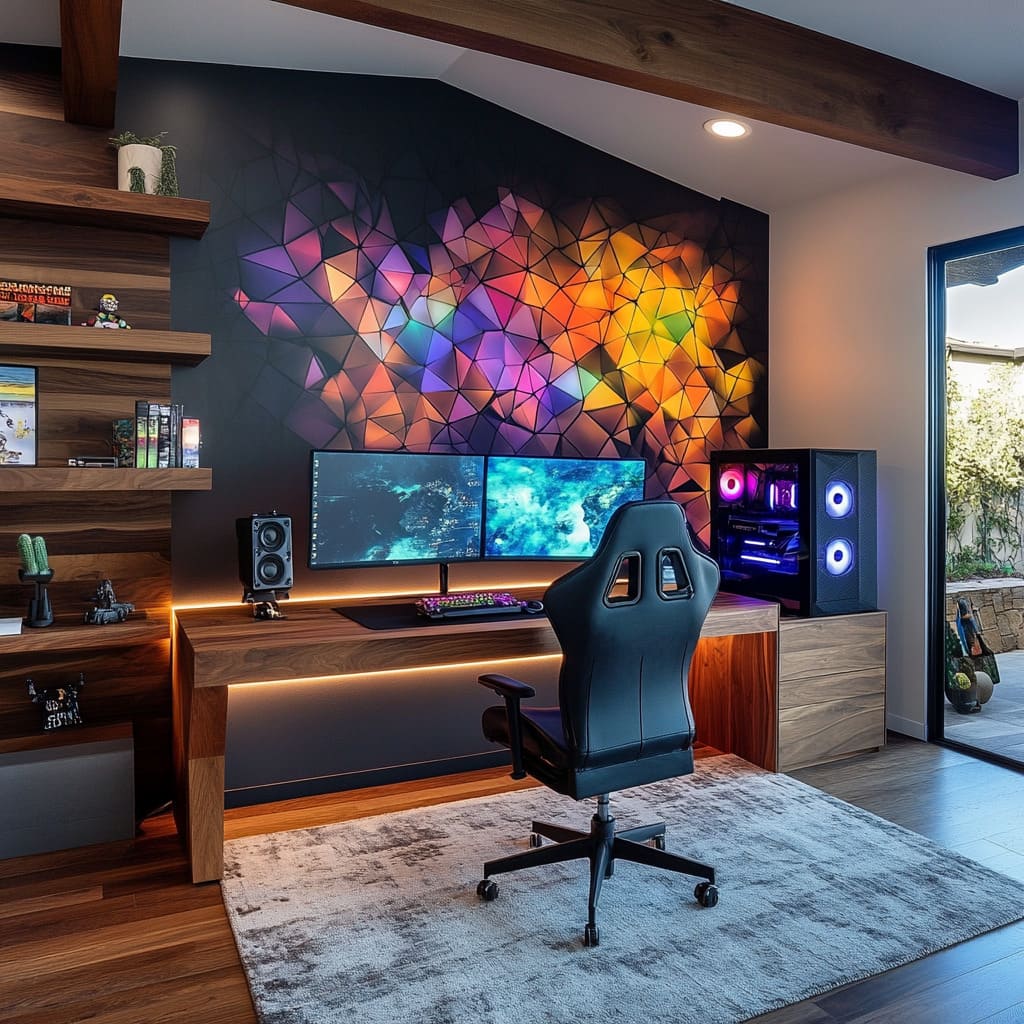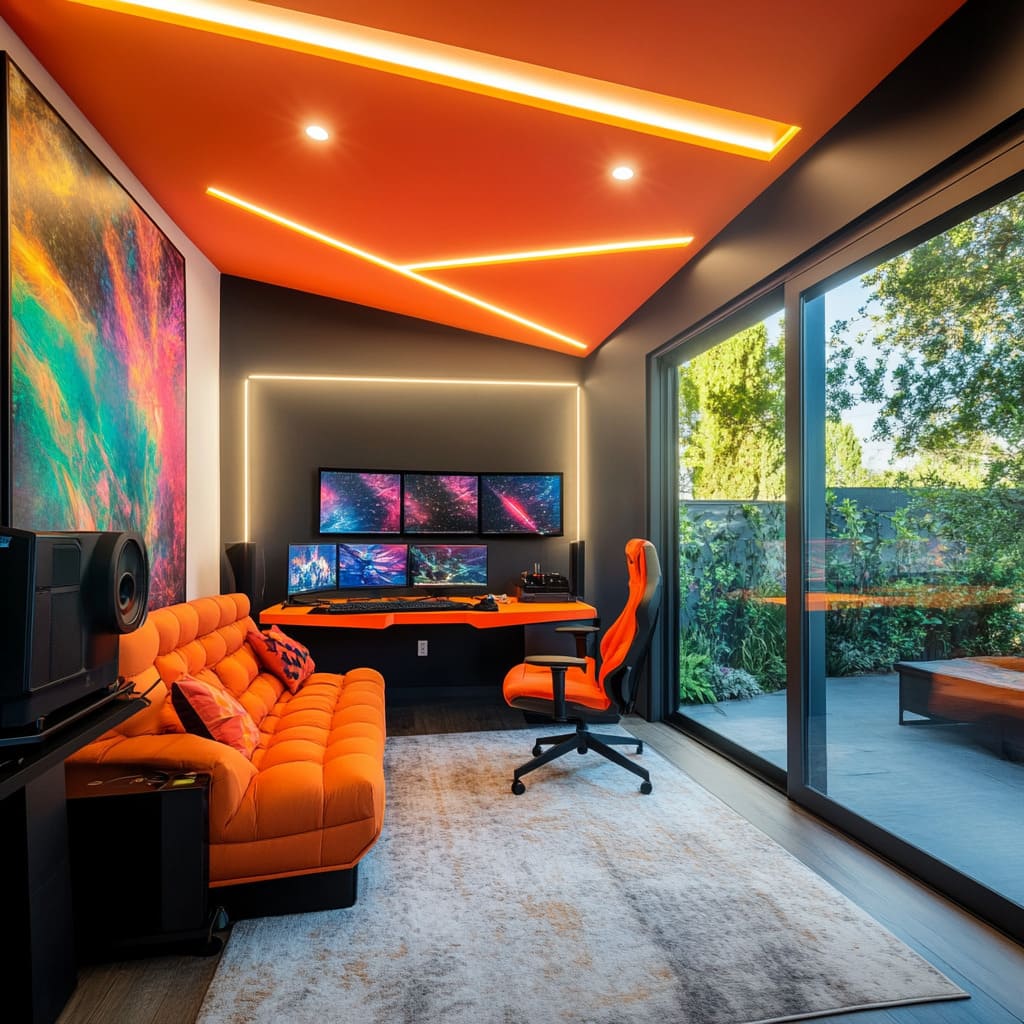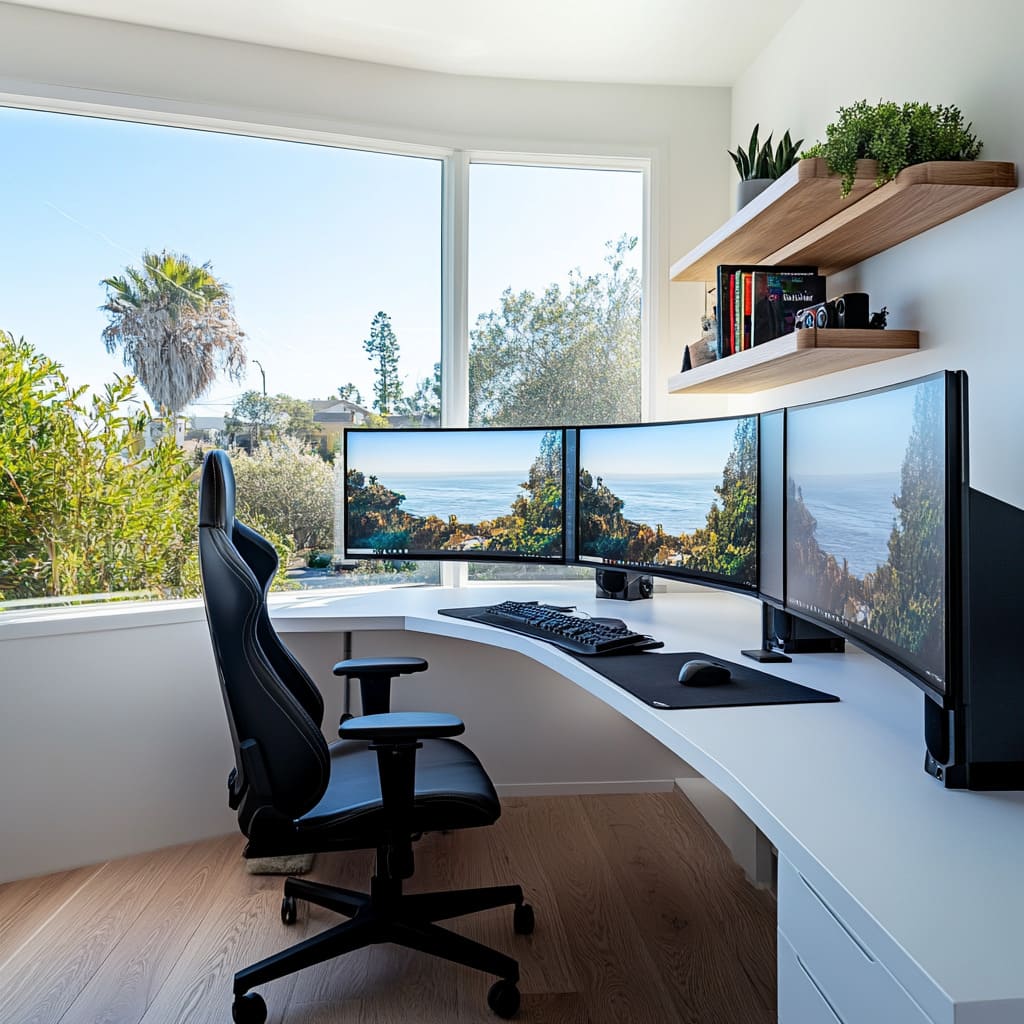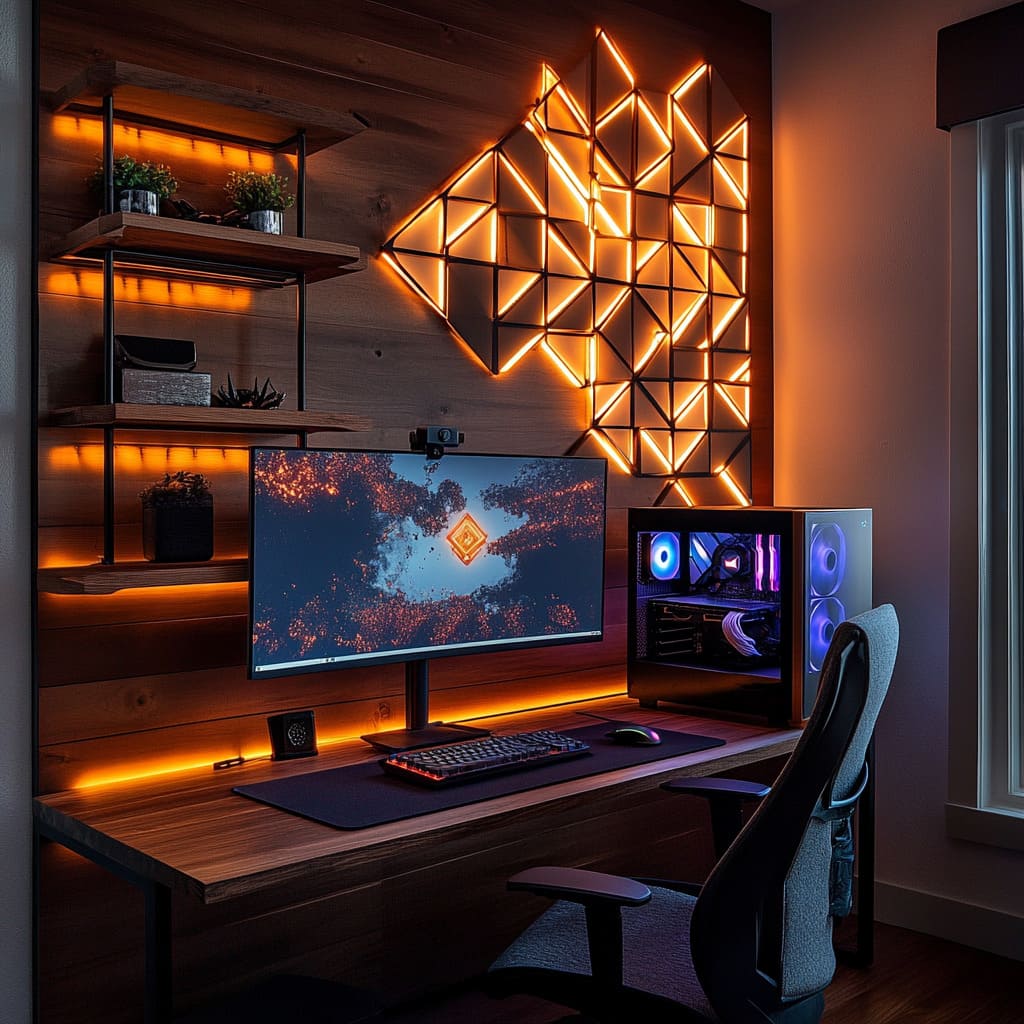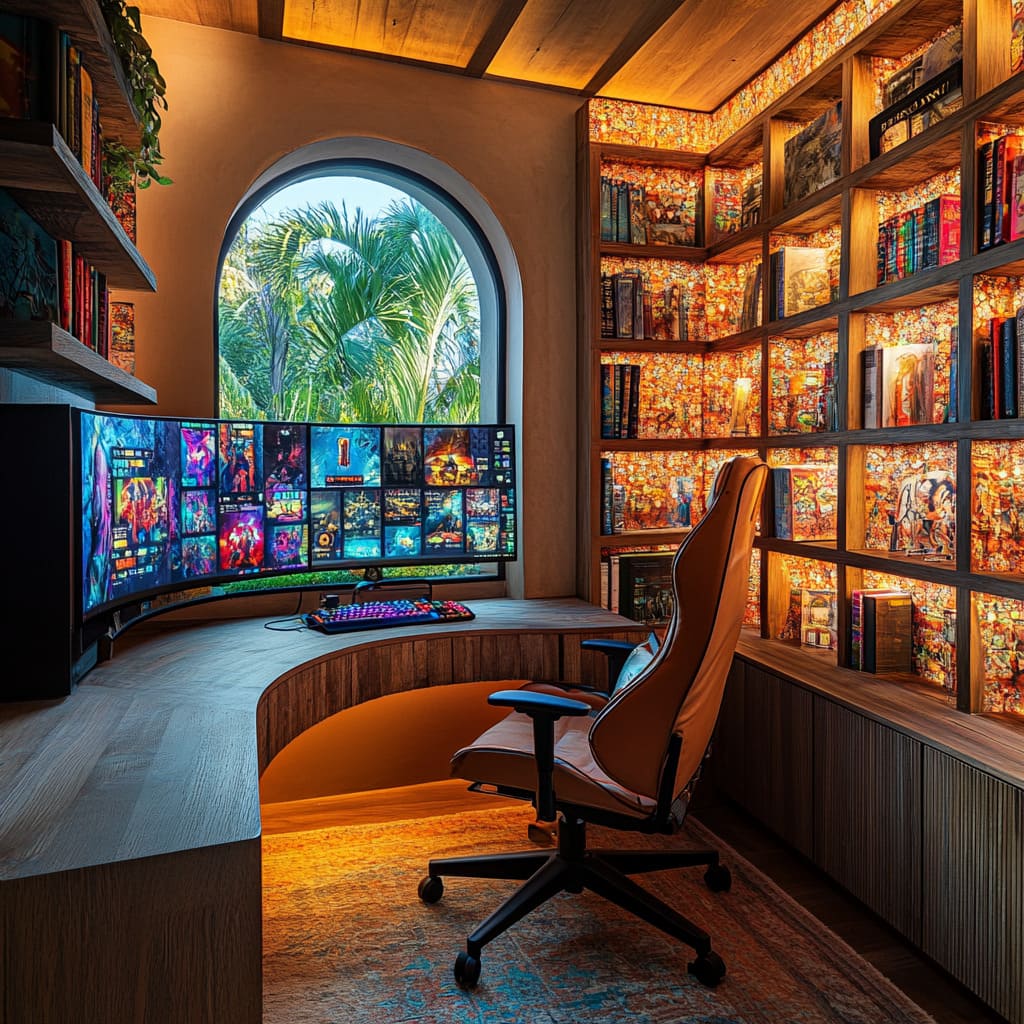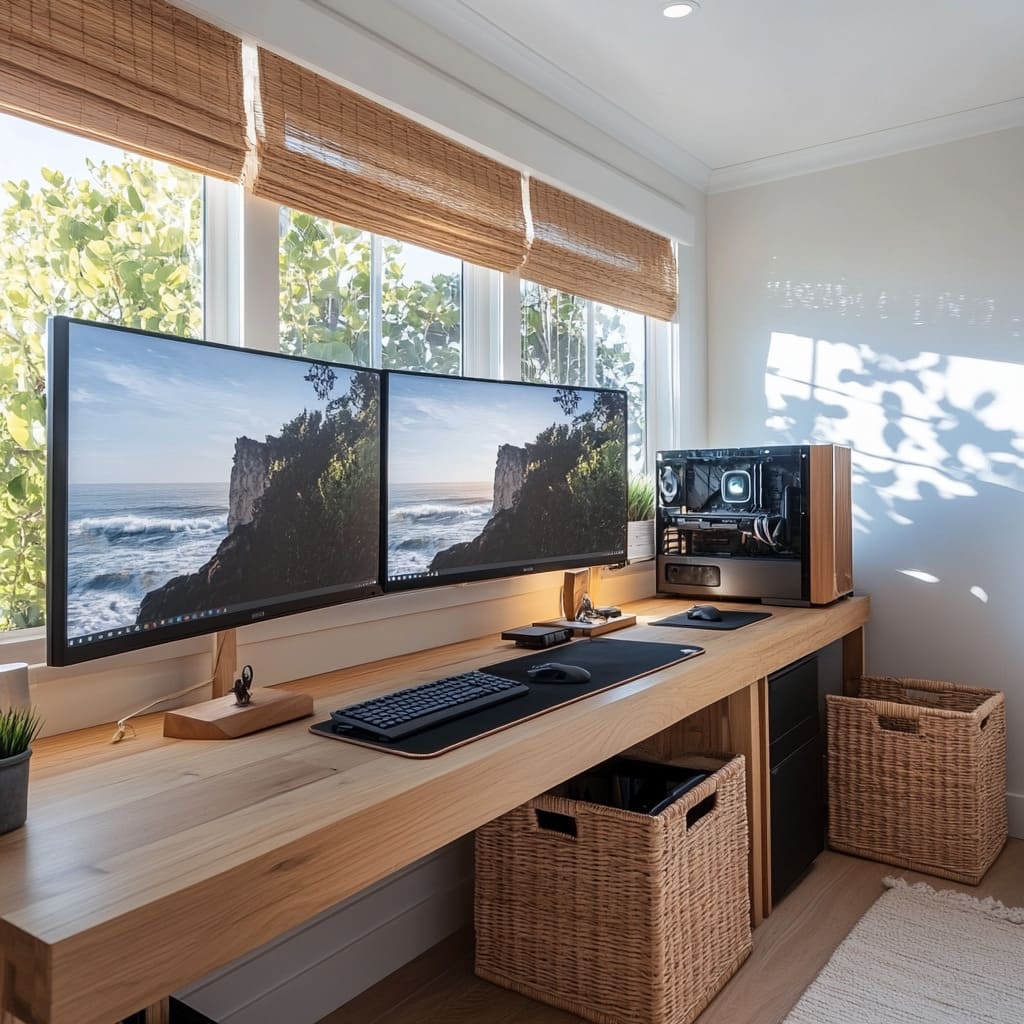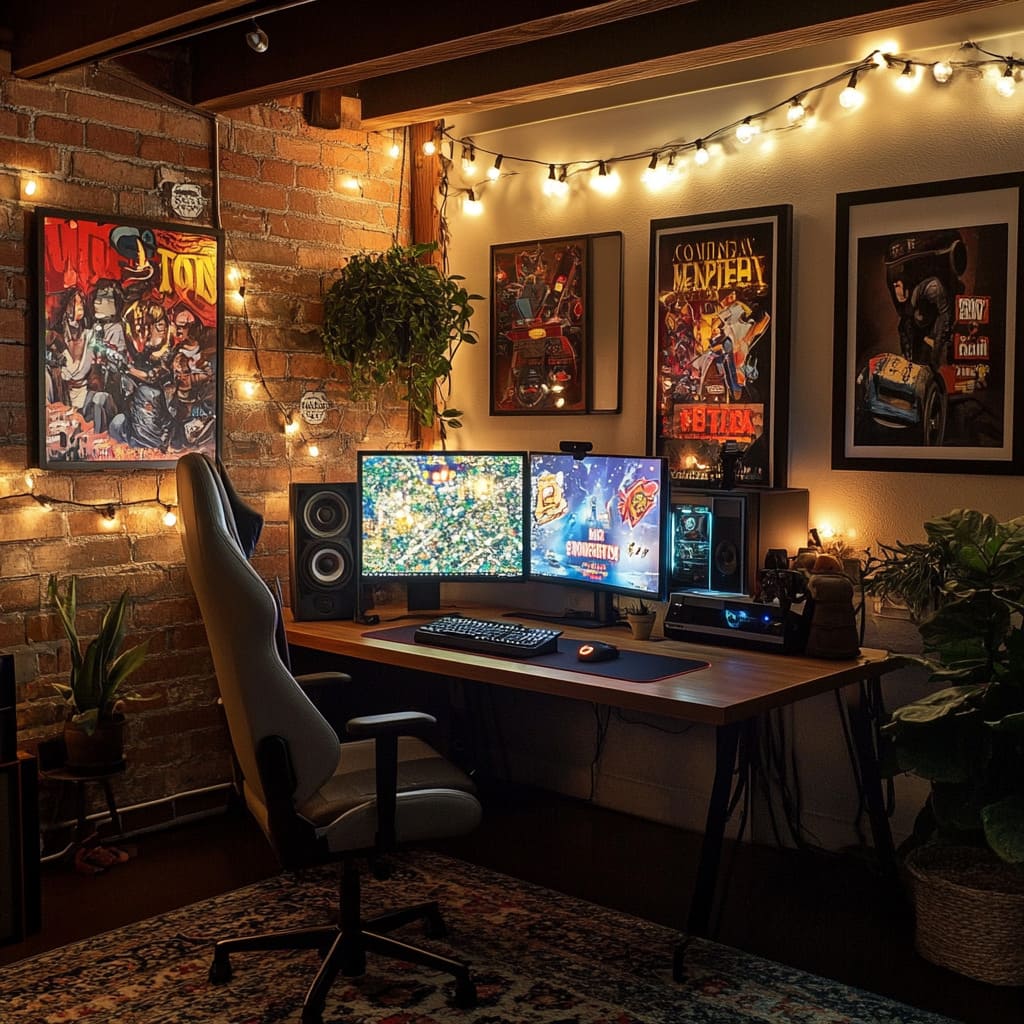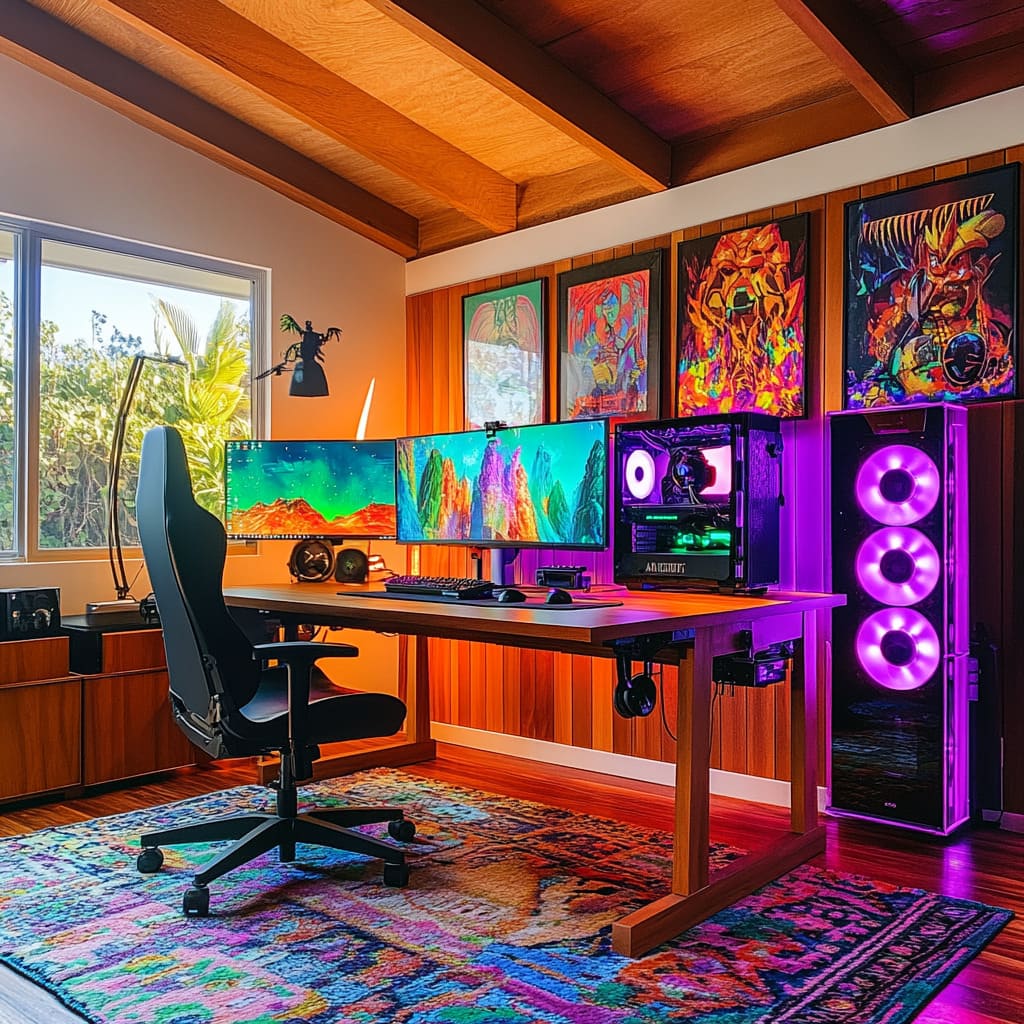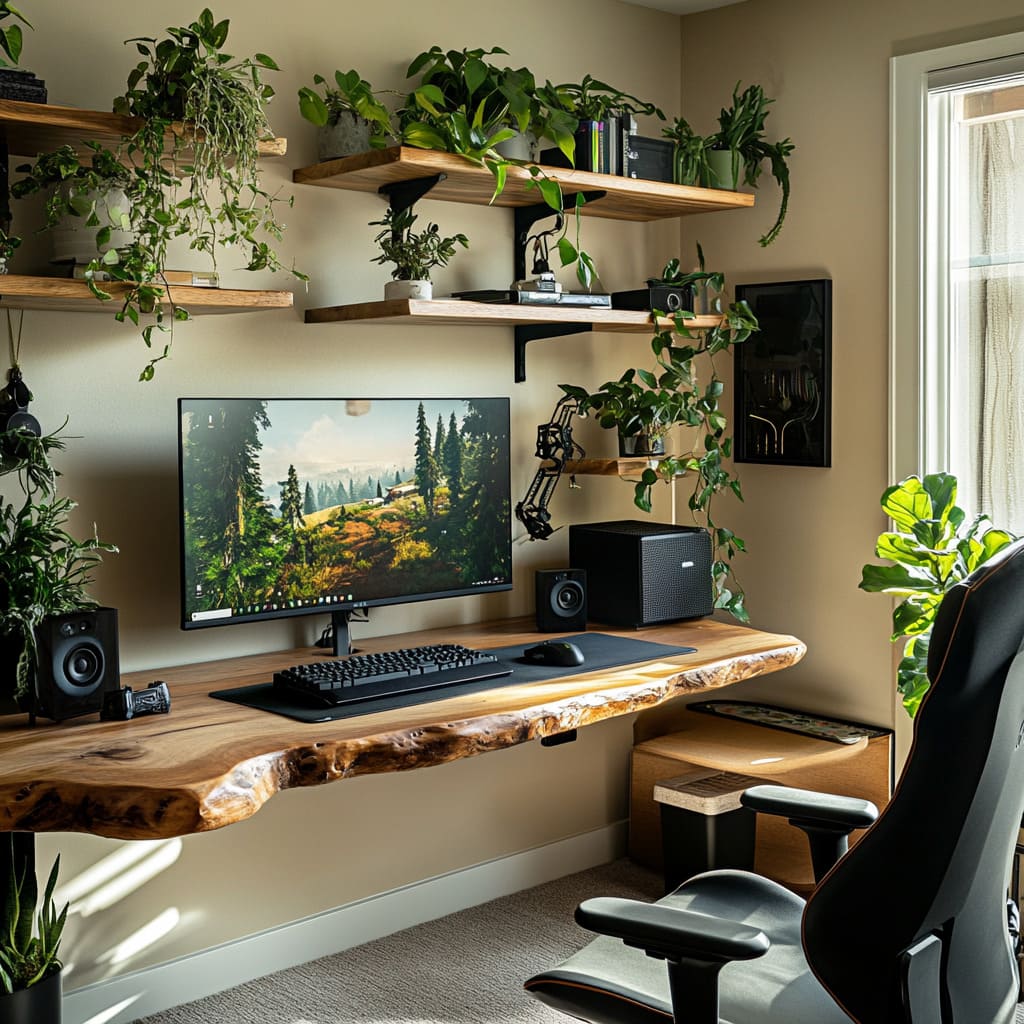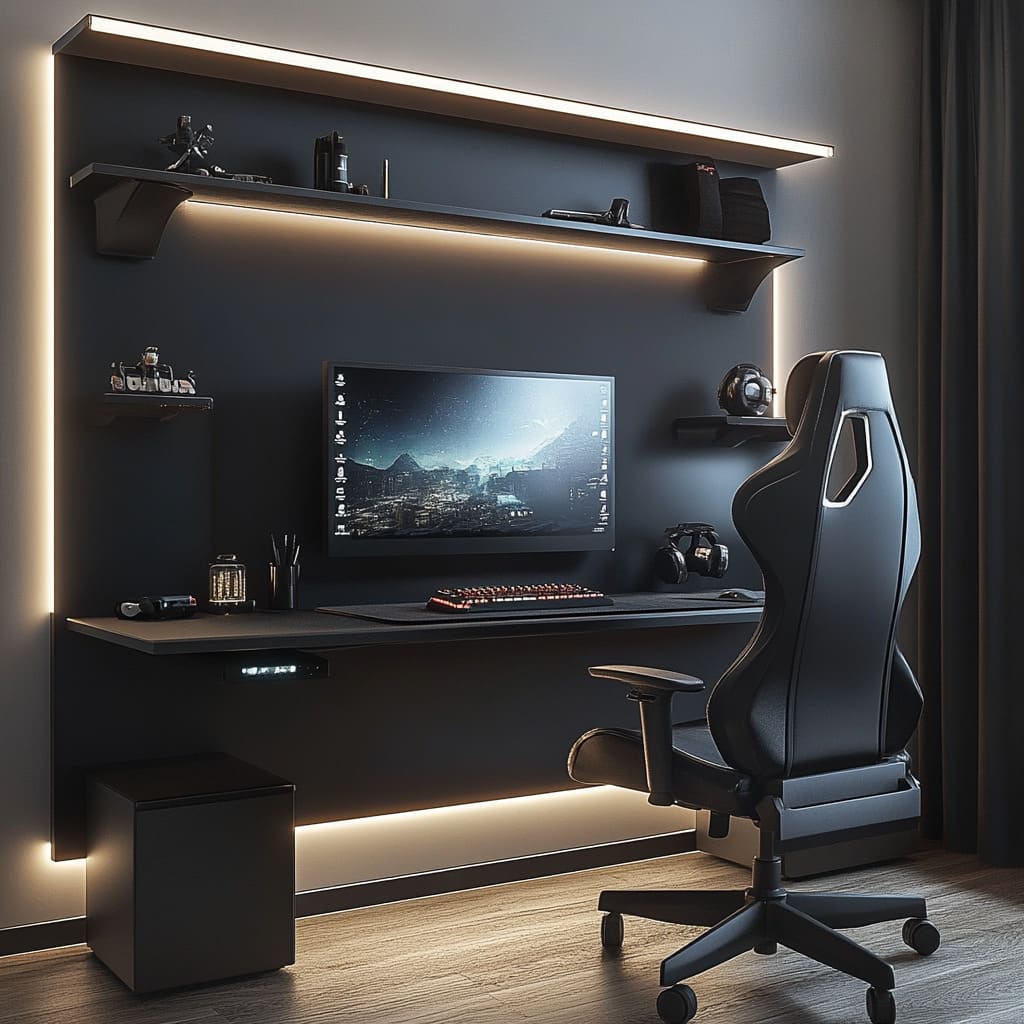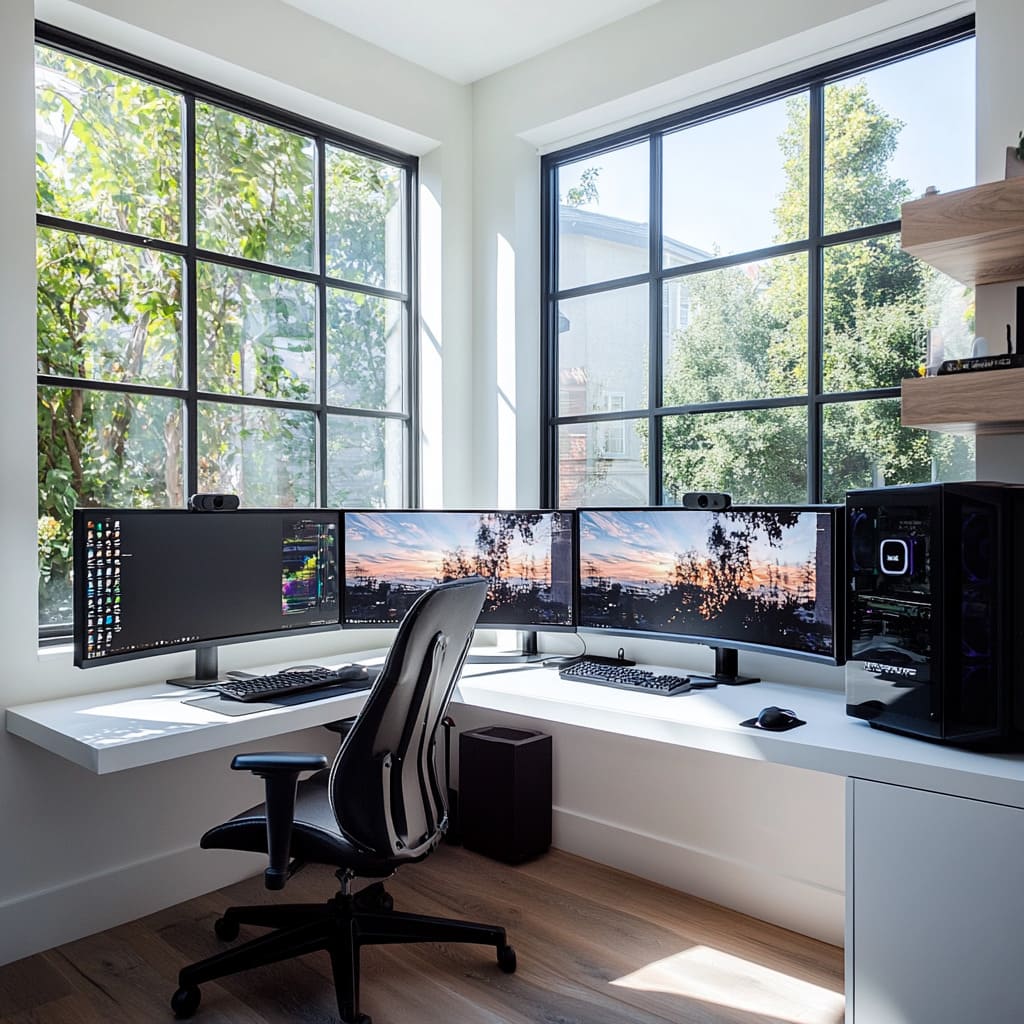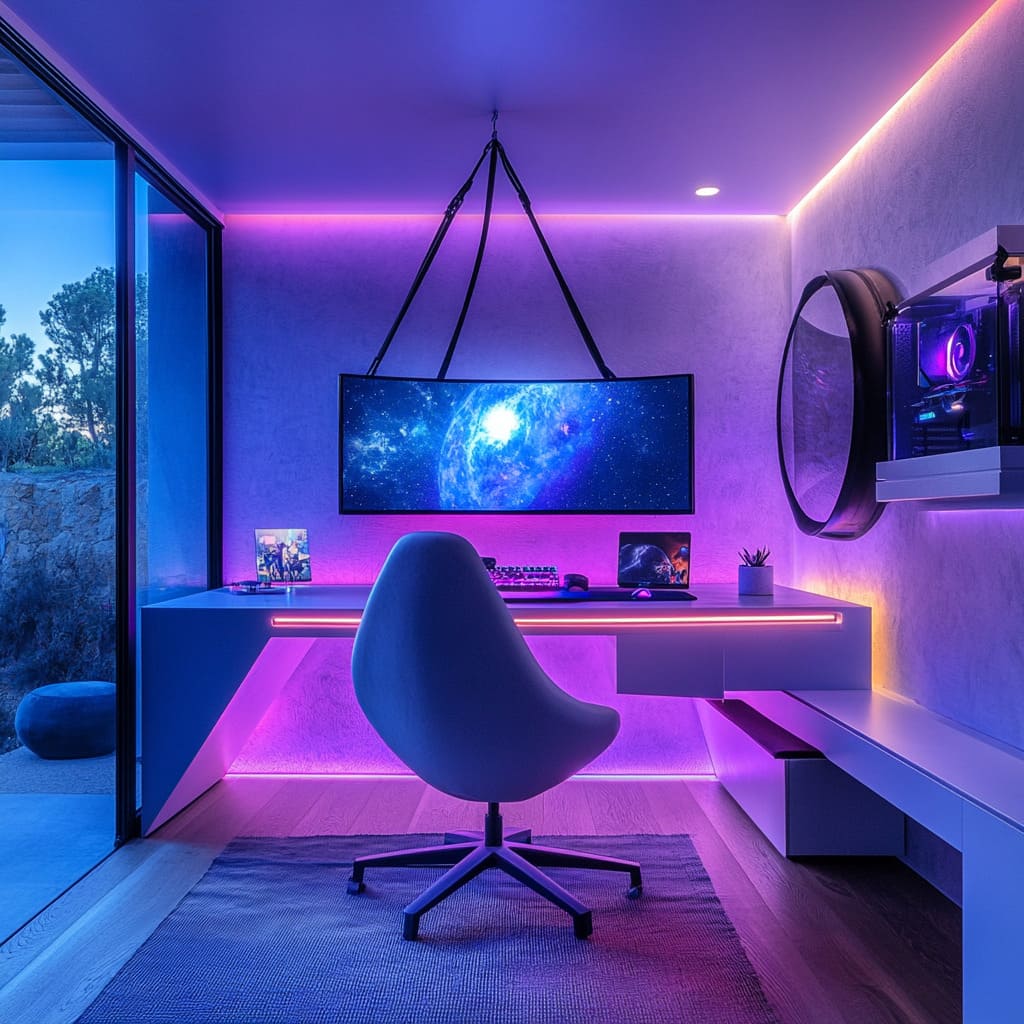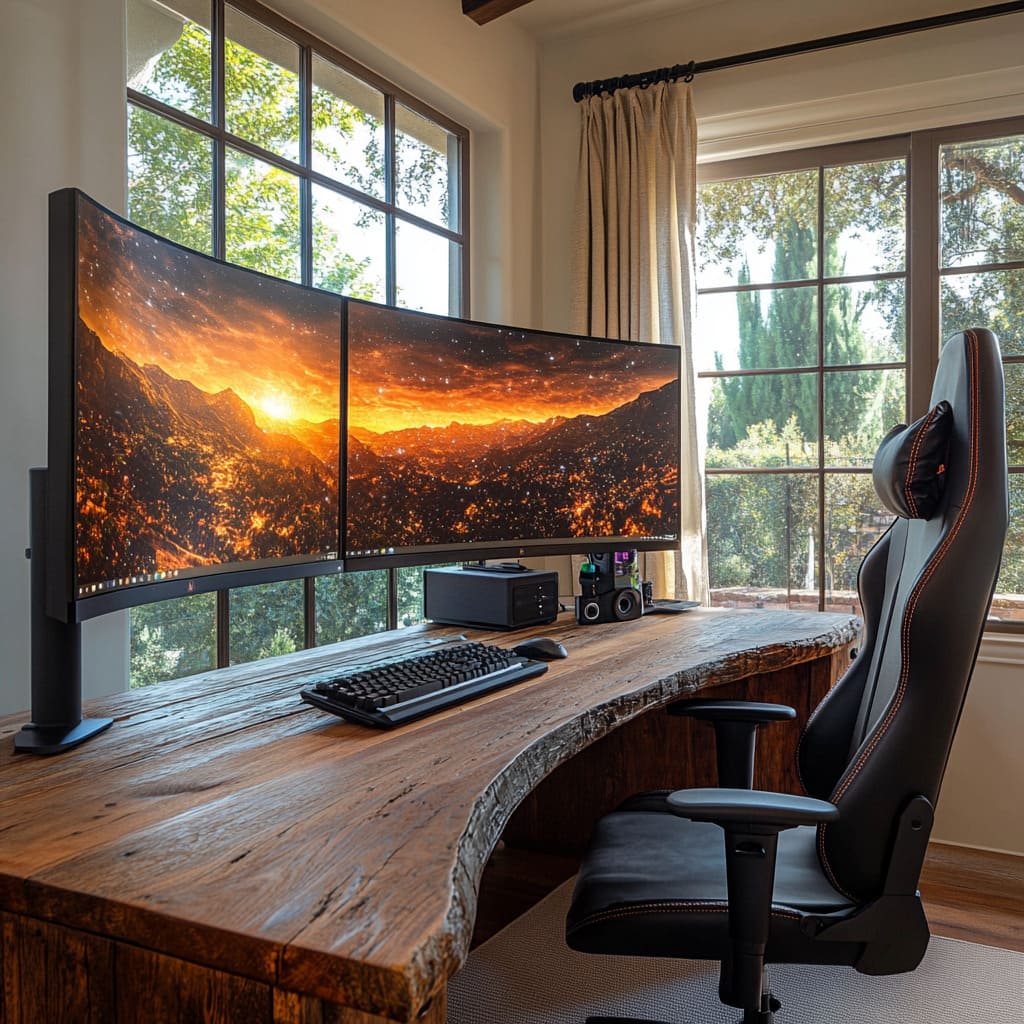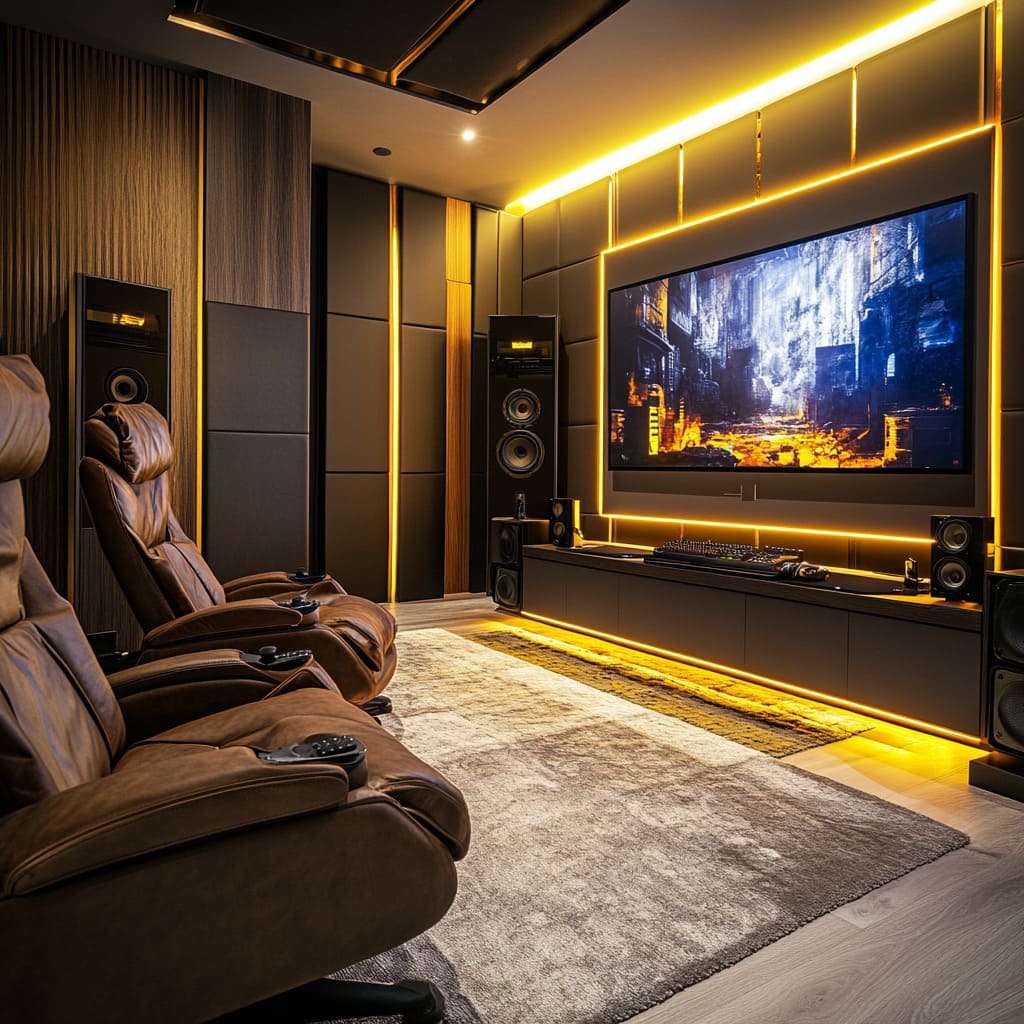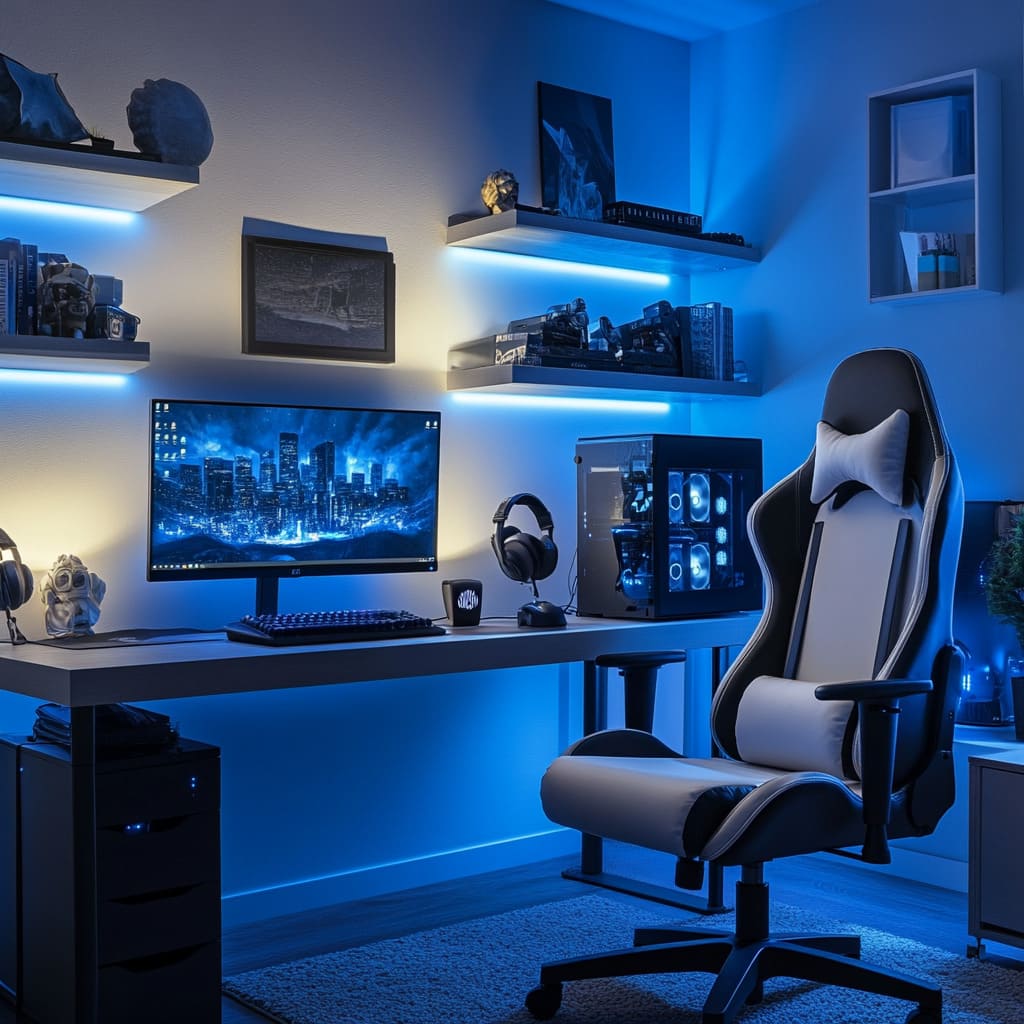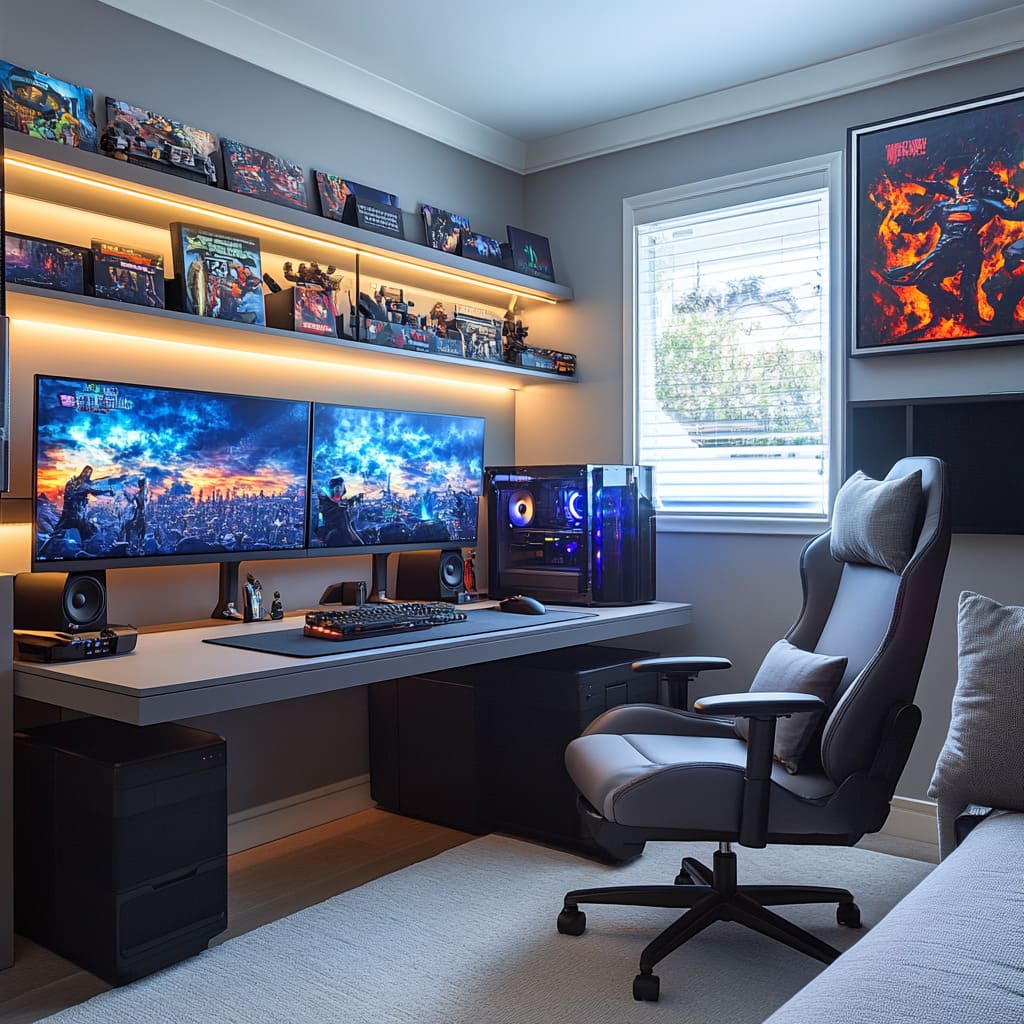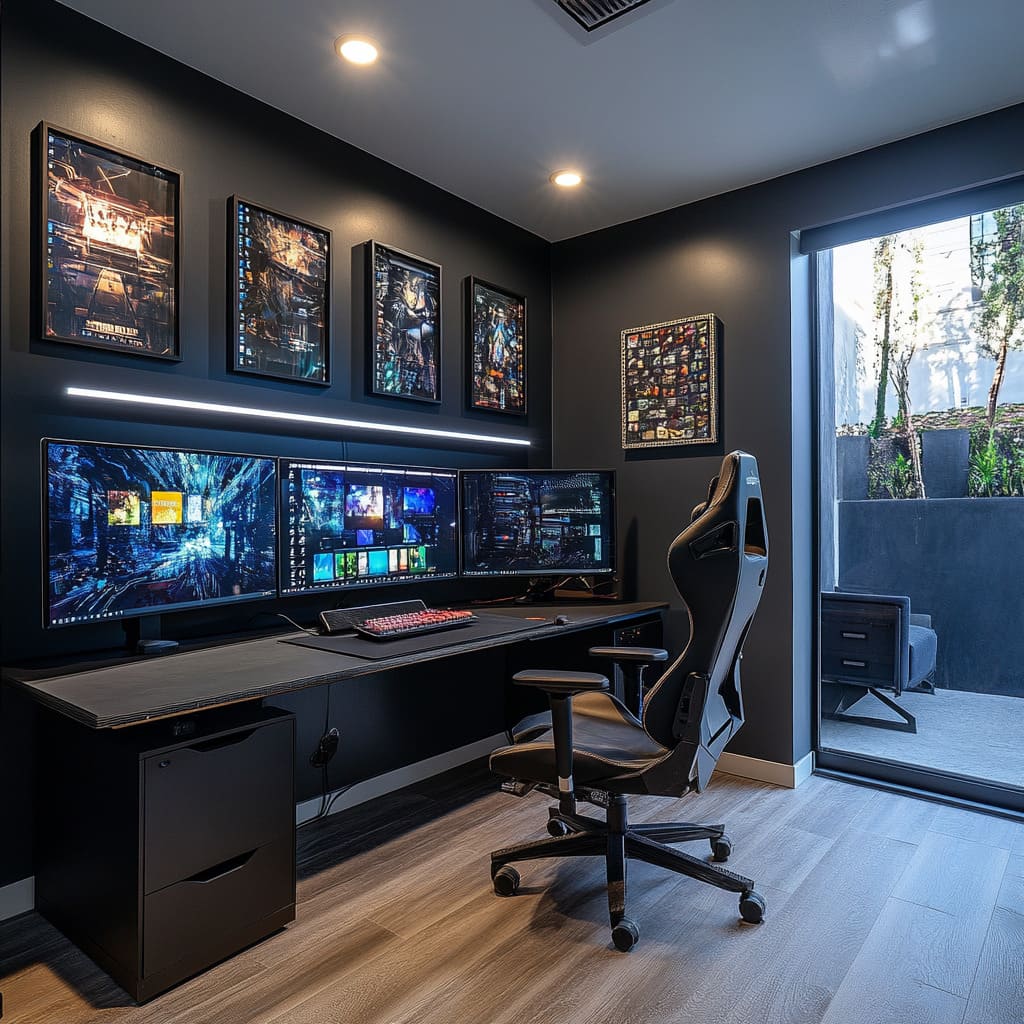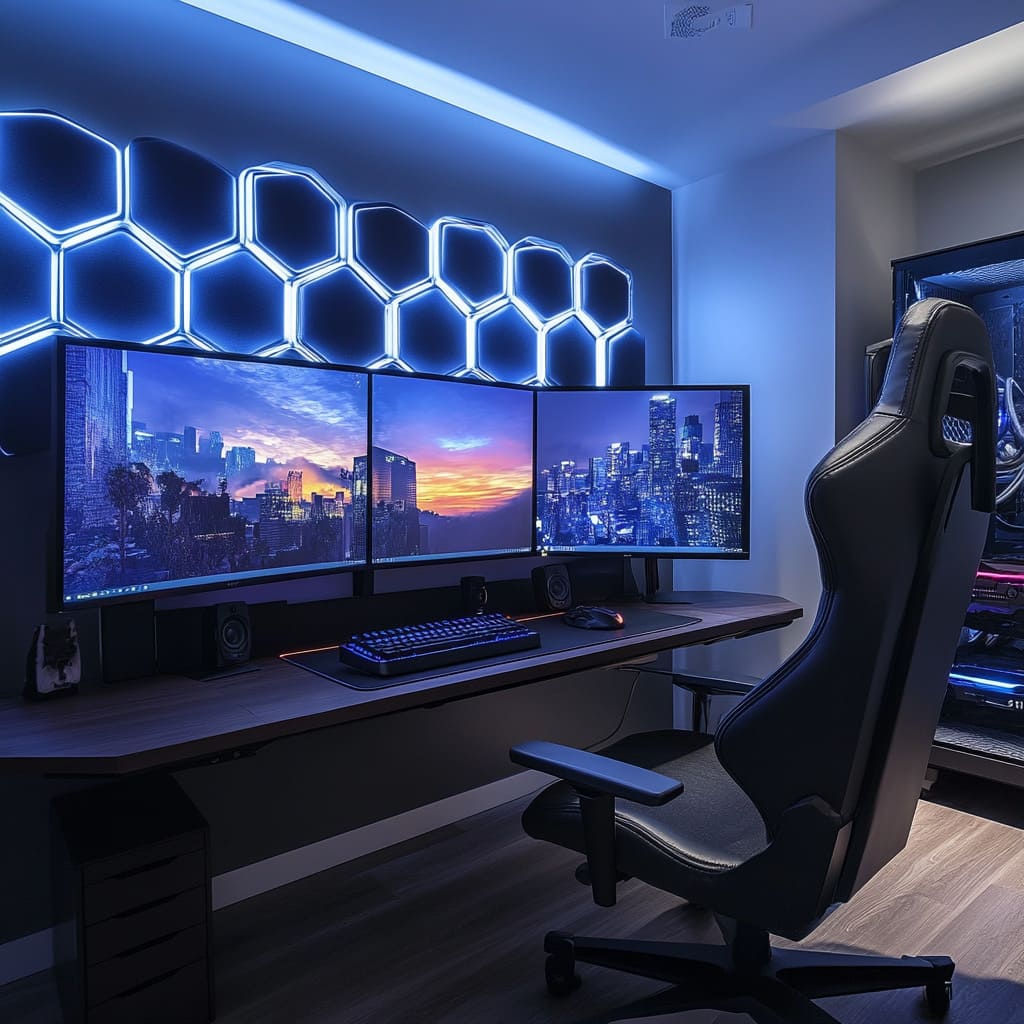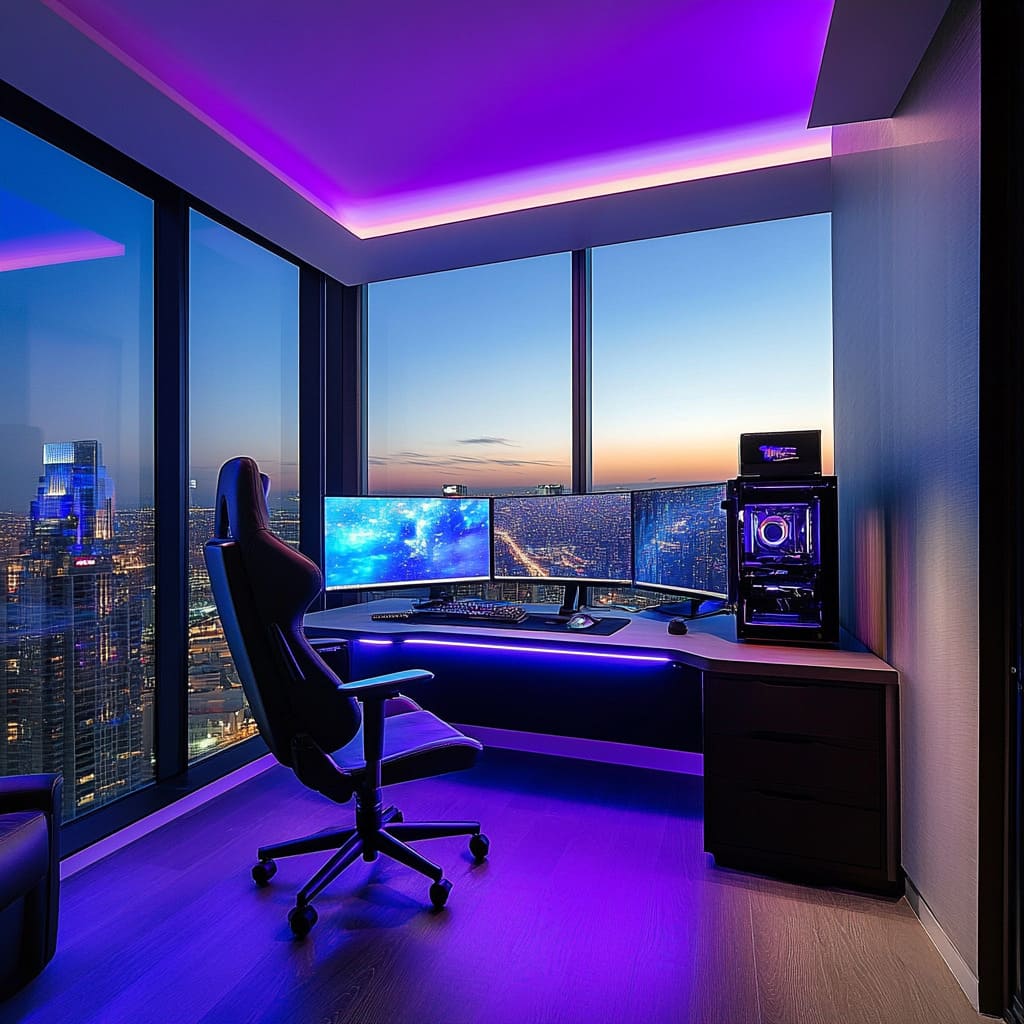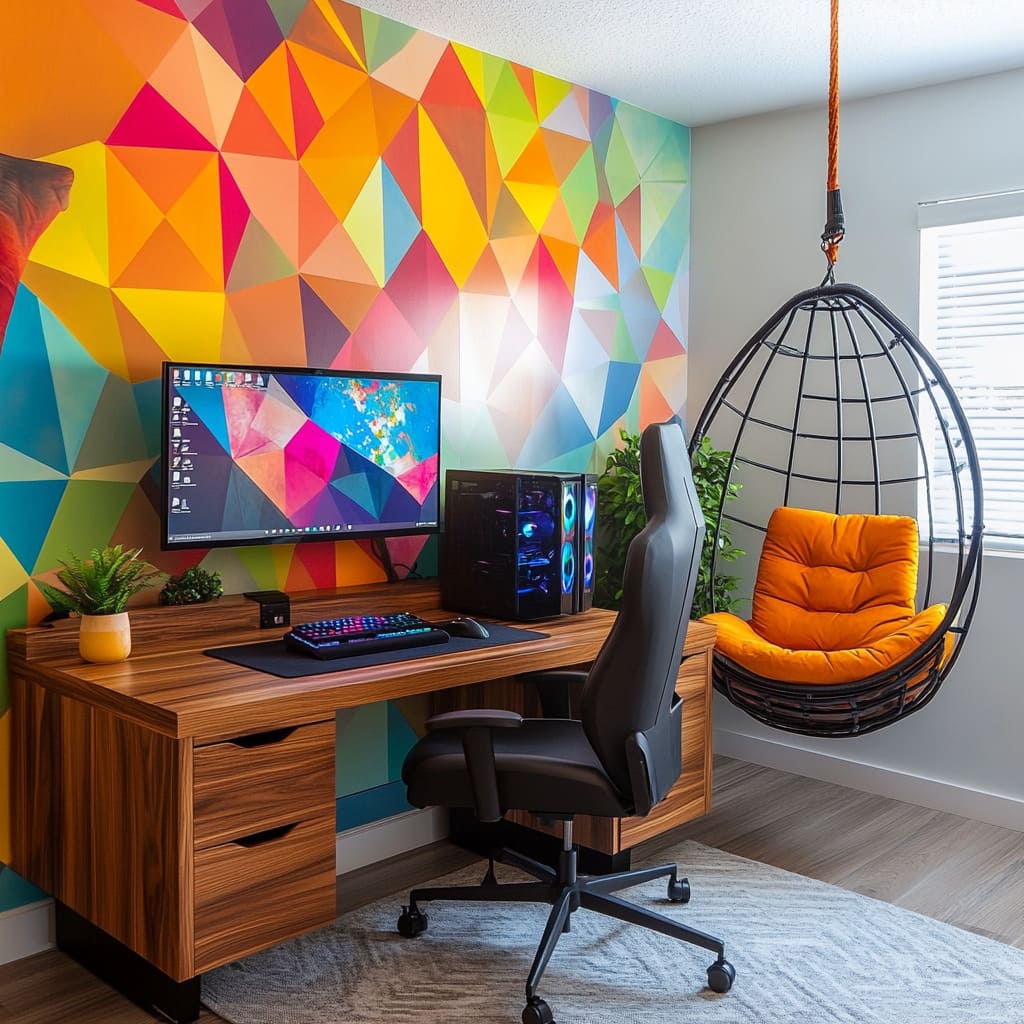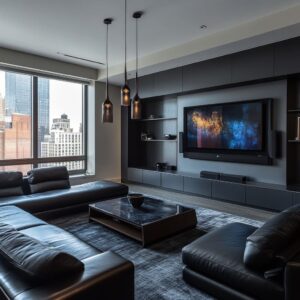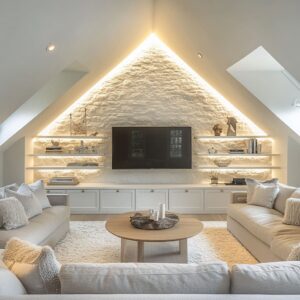Designing a gaming space is about more than setting up a desk and monitors—it’s an opportunity to create a room that reflects your personality, maximizes comfort, and enhances functionality. Whether you’re starting from scratch or looking to refresh your setup, there are countless gamer room design ideas to suit every style and need.
From sleek, modern layouts with cutting-edge tech to cozy corners filled with nostalgic elements, the possibilities are endless. In this article, we’ll explore practical tips and creative inspirations to help you design a gaming room that goes beyond aesthetics.
By focusing on lighting, acoustics, organization, and personal touches, you can transform any space into a gaming haven that’s both visually appealing and tailored to your gaming experience. Let’s dive into the key elements that make a gaming room stand out.
Strategic Use of Lighting and Layered Illumination
Lighting plays a pivotal role in shaping the atmosphere and functionality of a gaming space, with layered setups offering both visual appeal and practical benefits. Many gamer room ideas showcase a combination of lighting types, ranging from subtle LED strips to statement overhead fixtures.
This thoughtful layering creates a dynamic environment, offering flexibility to switch between an immersive gaming session and a well-lit general space.
Layered Lighting for Versatility
A mix of focused and ambient lighting ensures every corner of the room serves its purpose. For instance, LED strips placed behind monitors or along desk edges provide a soft, diffuse glow, reducing eye strain while keeping the focus on the screens.
Overhead lighting or floor lamps, on the other hand, brighten the entire space, ideal for non-gaming activities or creating a balanced ambiance.
Color Choices That Shape the Mood
The color temperature of lighting significantly affects the feel of a room. Warm tones like orange or soft white create an inviting, cozy atmosphere—great for cinematic gaming or casual relaxation.
Cooler tones, such as blue or purple, lend a futuristic, tech-inspired energy, perfect for high-performance gaming setups. Incorporating both tones in a single space can also emphasize architectural features, like alcoves or shelving, without overpowering the core design.
Strategic Placement for Functionality and Comfort
Where lights are installed makes all the difference. Many setups feature hidden LED strips tucked beneath desks or shelves, illuminating key areas without causing distracting glare.
Backlighting monitors or shelving not only improves visibility but also highlights your tech and décor in a sleek, modern way. When setting up lighting at home, ensure it’s positioned to avoid direct reflection on screens, which can disrupt focus and strain the eyes.
By carefully integrating various lighting elements, you can create a dynamic and adaptable gamer room that caters to both aesthetics and function. With the right balance of layers and tones, your gaming area can stand out while ensuring comfort and practicality.
Balancing Comfort and Style in Seating
The right chair is essential for any gamer room design, offering both comfort and a cohesive look that ties the space together. Gaming chairs are more than functional pieces—they’re part of the overall experience, blending ergonomics with style to enhance hours of use while complementing the design of the room.
Ergonomics That Support Long Sessions
A quality chair is an investment in health and comfort. Look for features like lumbar support, adjustable armrests, and recline tension control to maintain good posture during extended gaming.
A contoured seat can reduce fatigue, while headrests add extra support for the neck. These practical elements are key to staying comfortable without compromising focus.
Styling Chairs to Match Your Setup
A gaming chair doesn’t have to feel like an afterthought. Many designs now offer materials and trims that align beautifully with the room’s décor.
For example, a chair with leather upholstery might harmonize with wood paneling or a sleek desk finish. Choosing complementary colors or finishes creates a cohesive look, making the seating feel like part of the room rather than a standalone piece.
Adding Texture for Comfort and Warmth
For rooms that lean into a more relaxed or rustic aesthetic, adding textiles can completely transform the feel of your chair. A cozy throw or decorative cushion not only enhances comfort but also introduces a softer, inviting element to your setup.
Whether it’s a bohemian-inspired space or a minimalist tech-heavy room, small touches like these balance the high-tech vibe with a personal, homey feel. A well-chosen chair doesn’t just support the body—it completes the aesthetic and functionality of the gaming space.
By focusing on ergonomic features and thoughtful styling, your seating can elevate the overall experience while tying the entire room together seamlessly.
Desk Design and Material Choices
The desk is the centerpiece of any gaming room setup, balancing style, function, and personal preference. The right choice of materials, shape, and features can elevate your gaming experience while maintaining a practical and polished aesthetic.
Live-Edge vs Polished Wood
Live-edge desks offer a striking, organic appeal, especially in spaces inspired by rustic or nature-focused designs. Their irregular shapes and visible wood grains make them a focal point, bringing a touch of the outdoors inside.
On the other hand, polished or manufactured wood surfaces fit seamlessly into modern or minimalist setups, emphasizing clean lines and sleek finishes. The choice between the two depends on whether you want a bold natural statement or a streamlined look.
Shape and Configuration for Optimized Use
Desks come in various shapes, each suited to different room layouts and gaming needs. L-shaped or corner desks are ideal for setups that require multiple monitors or a mix of work and play, as they maximize surface area without taking up too much floor space.
Curved desks, often found in smaller gaming spaces, ensure ergonomic access to all peripherals, making them perfect for focused play. Whichever you choose, ensure it fits comfortably in your space and supports your preferred gaming habits.
Integrated Storage and Cable Management
Keeping clutter at bay is essential for a functional and visually appealing space. Many game room furniture ideas incorporate desks with built-in drawers or concealed shelves to store essentials like controllers, cables, or accessories.
Features like hidden compartments for power strips or cable management channels are game-changers, ensuring your setup stays tidy without compromising accessibility. A thoughtfully chosen desk goes beyond a simple workspace—it becomes a practical and aesthetic anchor for your gaming room.
Whether you lean toward rustic charm, modern minimalism, or a hybrid approach, the desk’s design can reflect your personal style while supporting a seamless gaming experience.
Audio Nuances and Acoustic Considerations
The audio setup is a vital component of any gaming space, enhancing immersion and creating a truly engaging experience. Whether you’re fine-tuning for competitive play or simply enjoying cinematic soundscapes, thoughtful planning in this area can make a significant difference.
These tips work well for both casual gamers and those exploring game room ideas for adults, where audio quality and sophistication take center stage.
Perfecting Speaker Placement
The positioning of your speakers plays a critical role in sound clarity and balance. Tower speakers or compact alternatives should ideally be placed at ear level and angled toward your seating position for optimal performance.
This ensures that you’re fully immersed in stereo or surround sound, capturing every detail from in-game footsteps to cinematic explosions.
Dampening Echoes with Soft Surfaces
Good sound isn’t just about the speakers—it’s also about how sound behaves in the room. Hard surfaces, such as bare walls or hardwood floors, can cause echoes or harsh reflections that muddle the experience.
Carpets, thick rugs, or strategically placed fabric wall hangings can absorb these unwanted sound waves. For a more creative touch, decorative elements like wood slats or brick accents can double as acoustic solutions while elevating the room’s style.
Managing Bass Without Disturbing the Neighbors
Subwoofers add depth to the sound experience, but they can also create vibrations that transfer through walls or floors. To avoid this, consider placing the subwoofer on a heavy surface or using rubber isolation pads.
Positioning it in a corner or under a desk can amplify the bass effect without excessive noise bleed into other rooms. By focusing on strategic speaker placement, room acoustics, and bass control, you can create an audio environment that feels tailored to your needs.
These adjustments not only enhance gaming sessions but also ensure that your space is as enjoyable for relaxed music or movie nights as it is for intense battles on screen.
Window Placement and Natural Light
The way windows are incorporated into a gaming setup can significantly impact both functionality and ambiance. Natural light adds an uplifting energy to the room, but its placement and control require careful consideration to avoid disrupting gameplay.
Whether you’re looking for inspiration or brainstorming video game room ideas, window design is a key element that can elevate the space.
Managing Glare for Better Gameplay
Large windows are often a standout feature, flooding rooms with daylight and connecting the space to its surroundings. However, glare on screens can be a persistent challenge.
Adjustable coverings like bamboo blinds or thick curtains are effective solutions, allowing you to balance brightness with usability. For gaming spaces where adaptability is crucial, motorized shades offer convenience and precision.
Balancing Practicality with Stunning Views
Floor-to-ceiling windows can provide breathtaking scenery—whether it’s a city skyline, oceanfront, or a lush garden—but direct sunlight can interfere with monitor visibility. Frosted films or sheer curtains are excellent for softening harsh rays while maintaining an open, airy vibe.
These options let you enjoy the view without compromising your gaming setup’s functionality.
Introducing Greenery for a Calming Touch
Placing plants near windows not only enhances aesthetics but also creates a natural balance in a tech-dominated environment. Greenery thrives in natural light, bringing fresh air and a sense of relaxation to the space.
From potted succulents to larger statement plants, these additions help soften the overall look and make the room feel more inviting. With a thoughtful approach to window placement and light control, you can design a gaming room that feels connected to the outside world while keeping distractions to a minimum.
Whether it’s creating the perfect balance of light and shade or incorporating biophilic touches, windows can transform the way your space feels and functions.
The Role of Color and Theme Cohesion
Color and theme cohesion are essential for creating a polished and immersive gaming room. Whether the goal is to achieve visual harmony or to separate different functional zones within the space, a deliberate approach to color can make a significant impact.
These principles are particularly useful when planning home game room ideas that combine style and functionality.
Coordinating Monitors and Room Palette
Matching your monitor’s background or scenic wallpapers to the room’s overall color scheme is an often-overlooked detail that ties everything together. Coastal-inspired setups might feature ocean vistas on the screens, while urban loft designs could display cityscapes that reflect the surrounding décor.
This subtle alignment enhances the sense of continuity, making the entire space feel cohesive and thoughtfully designed.
Consistency in Lighting and Accents
Using a unified color palette across elements such as LED lighting, PC towers, and smaller accessories helps maintain a streamlined look. For example, pairing purple LEDs with black furniture or combining warm orange hues with natural wood creates a striking and consistent aesthetic.
Small details like matching the keyboard backlighting or choosing desk décor in complementary shades further amplify the theme without overwhelming the room.
Defining Zones with Subtle Variations
In multi-purpose spaces, color can also help distinguish different areas while ensuring they still feel connected. For example, a gaming corner might feature bold, vibrant tones, while a nearby lounge area could use softer, muted hues.
This approach allows each zone to serve its purpose while blending seamlessly into the overall design. By focusing on color and theme cohesion, you can create a space that feels balanced, immersive, and highly personalized.
Whether you’re aiming for a minimalist aesthetic or a vibrant, high-energy vibe, consistent attention to color across all elements will ensure your gaming room stands out in both style and functionality.
Organization, Cable Management, and Display of Tech
A well-organized gaming space doesn’t just look good—it enhances functionality and makes the entire setup more enjoyable to use. Attention to detail in how tech and accessories are displayed, and how cables are managed, is a hallmark of the best game room ideas.
By combining clean aesthetics with practical solutions, you can create a setup that feels both efficient and visually striking.
Open vs Concealed PC Towers
The placement of your PC tower can define the room’s character. Open display towers, especially those with glass panels and synchronized RGB lighting, often serve as statement pieces.
They showcase the advanced hardware inside and add a dynamic visual element to the room. Alternatively, concealing the tower within a desk compartment or side cabinet allows other elements, such as monitors or decorative accents, to take center stage.
The choice between showcasing or concealing depends on whether you want the PC to be a visual focal point or blend into the background.
Showcasing Collectibles with Floating Shelves
Floating shelves are a fantastic way to incorporate personality into your gamer room. Backlighting or spotlighting these shelves can turn memorabilia into eye-catching decor, whether it’s action figures, books, or awards.
To avoid a cluttered look, give each item enough breathing room and use LED strips along the shelf edges for subtle illumination without harsh glare. This approach elevates the visual impact while keeping the space organized.
Clever Cable Management
Nothing disrupts the clean look of a gaming room more than tangled wires. Successful setups often appear wire-free thanks to thoughtful cable management strategies.
Techniques like using cable channels underneath desks, securing cords with velcro ties, or integrating wire conduits into the desk frame keep everything neatly hidden. These solutions ensure your gaming area stays sleek and distraction-free, whether you’re gaming or simply enjoying the space.
By focusing on how your tech is displayed and keeping your setup tidy, you can create a gaming room that balances style with practicality. These organizational touches, combined with a personal flair in showcasing collectibles, will leave a lasting impression while improving daily use.
Subtle Tech and Architectural Integrations
Blending modern technology with thoughtful architectural elements can turn a standard gaming setup into a seamless part of your home’s design. From soundproofing to lighting choices, these integrations offer functional and aesthetic benefits, making them a great source of gaming room inspiration for any space.
Hidden Soundproof Panels for Enhanced Acoustics
Effective soundproofing doesn’t have to disrupt the room’s design. By incorporating acoustic materials behind decorative wood paneling, you can reduce external noise and contain in-room sound without compromising on style.
Foam panels or specialized acoustic solutions can be integrated into walls discreetly, maintaining a sleek appearance while ensuring optimal audio quality.
Lighting Panels as Functional Art
Hexagonal or triangular LED panels on walls serve a dual purpose: they provide illumination and act as artistic focal points. These panels can emphasize geometric patterns already present in the room or introduce a modern edge to a minimalist space.
When using these features, adjustable color and intensity options are crucial to ensure the lighting complements the room rather than overwhelming it.
Bridging Architectural Styles with Modern Tech
Historical and traditional design features, such as Spanish Colonial arches, Craftsman-style details, or rustic ranch beams, can harmonize beautifully with modern gaming setups. The secret lies in complementary materials—pairing warm wooden desks or leather seating with the clean lines and vibrant glow of LEDs creates a cohesive look.
This approach allows technology to blend naturally into older architectural spaces, offering a balanced fusion of old and new. By weaving these subtle integrations into your gaming room, you can craft a space that feels intentional and tailored to your style.
Whether you’re enhancing the acoustics, experimenting with lighting, or blending architectural elements, these ideas ensure that your gaming setup doesn’t just function—it becomes part of a thoughtful, cohesive design.
Incorporating Personal Identity and Hobbies
Adding a personal touch to your gaming space transforms it from a generic setup into a true reflection of your personality. Whether through curated art, cherished collectibles, or hobbies displayed with pride, these elements bring depth and warmth to the room while offering cool decorations for gaming room designs that stand out.
Showcasing Art and Posters That Reflect Your Style
Framed retro gaming posters, abstract murals, or bold geometric patterns can elevate the visual appeal of your space while showcasing your unique taste. Positioning these pieces strategically—behind your desk or along side walls—ensures they remain in your peripheral view during gameplay without becoming overwhelming.
Choosing themes or designs that resonate with your favorite games or genres adds a personalized touch to the room’s decor.
Highlighting Collectibles with Thoughtful Lighting
Shelves dedicated to figurines, statues, or game-themed memorabilia can be a striking addition, especially when paired with lighting accents. LED strips that match your room’s color scheme can draw attention to these items, turning them into a functional part of the design.
Placing them behind glass or in enclosed shelves not only enhances their presentation but also minimizes dust, keeping your collection pristine.
Balancing Technology with Other Hobbies
A purely digital setup can sometimes feel impersonal. Incorporating elements from your other interests—like a guitar stand, a shelf of books, or board games—adds variety and softens the high-tech vibe.
These features make the space more welcoming for guests while giving you a multi-purpose room that reflects the full range of your passions. Personalizing your gaming room with carefully chosen decorations and a mix of hobbies makes the space feel authentic and engaging.
Whether it’s highlighting your favorite games through art or blending in elements from other interests, these choices ensure your gaming setup feels truly your own.
Practical Tips for Replicating These Ideas at Home
Creating a personalized and functional gaming space is easier when you start with a solid plan. From lighting to decor, each detail contributes to a setup that’s both stylish and ergonomic.
These practical tips can help bring your favorite PC gaming room ideas to life while ensuring your space is uniquely tailored to your needs.
Plan Lighting First for a Clean Setup
The placement of lighting should be decided before furniture arrives. Whether you’re installing LED strips, ceiling fixtures, or desk lamps, early planning allows you to hide cords effectively and avoid awkward layouts.
This approach not only keeps the room tidy but also ensures optimal light distribution.
Focus on Ergonomics
A comfortable gaming experience starts with proper screen placement. Your primary monitor should be positioned at eye level and roughly an arm’s length away.
This simple adjustment can significantly reduce strain on your neck and eyes, especially during extended sessions. The same consideration should apply to desk and chair height for full-body comfort.
Test Colors Under Different Lighting Conditions
If you’re painting walls or installing panels, use color swatches to see how the hues interact with both natural daylight and artificial lighting. This is particularly important in gaming setups, where LED lighting can dramatically alter the appearance of colors at night.
Start with a Focal Point
Identify a standout feature for your gaming room, such as a multi-monitor array, a custom-built desk, or a bold piece of wall art. Once the focal point is established, you can design around it, ensuring that other elements complement rather than compete with it.
This creates a balanced yet visually engaging layout.
Incorporate Personal Touches
Adding a few cherished items, such as framed photos, collectible figures, or motivational posters, can give your space character. These small details transform a generic room into one that reflects your personality, making it feel truly yours.
By following these steps, you can design a gaming room that is both functional and uniquely personal. From thoughtful lighting to personalized decor, these choices will help you craft a space that stands out while delivering comfort and style.
Conclusion
A thoughtfully designed gaming space goes beyond flashy gadgets and bright LEDs—it’s about creating an environment that feels comfortable, functional, and true to your personality. By paying attention to the finer details, like layered lighting, acoustic enhancements, carefully chosen materials, and smart organization, you can craft a space that works for both intense gaming marathons and laid-back downtime.
Whether you’re drawn to sleek futuristic setups or prefer a cozy vintage aesthetic, the key lies in adapting features that align with your needs. Hidden acoustic panels, strategically placed plants, or curated LED lighting can transform a room into a seamless blend of function and style.
These details elevate the overall experience while reflecting your taste.
Incorporating unique gamer room decor, like customized collectibles or personalized accents, brings an extra layer of character to your space. These small yet meaningful touches ensure your setup feels less like a showroom and more like a reflection of your lifestyle.
By combining creativity with practical design, you’ll build a gaming room that’s truly your own.

